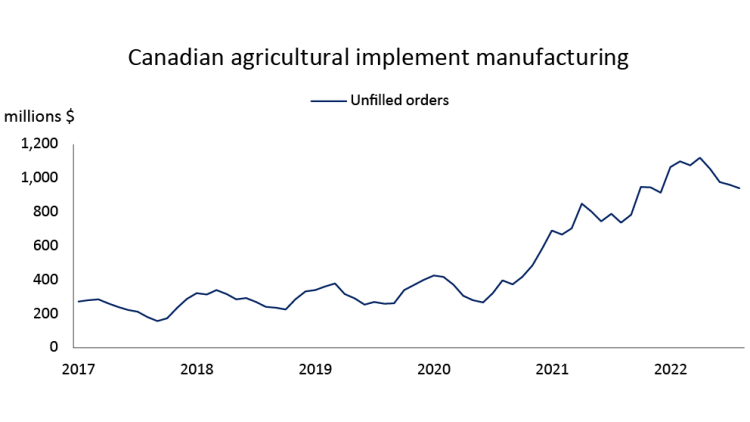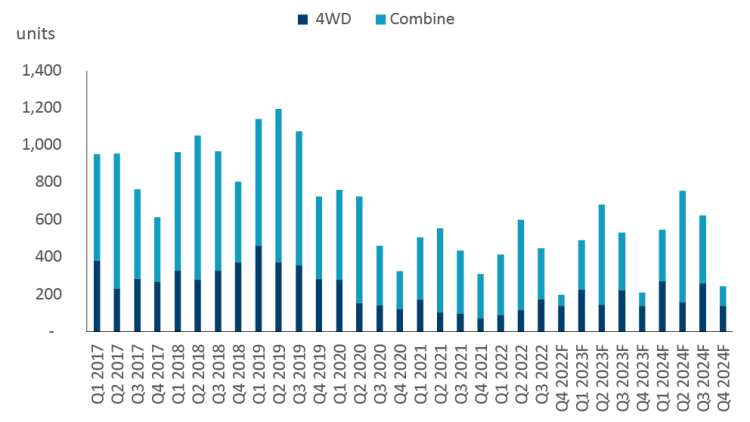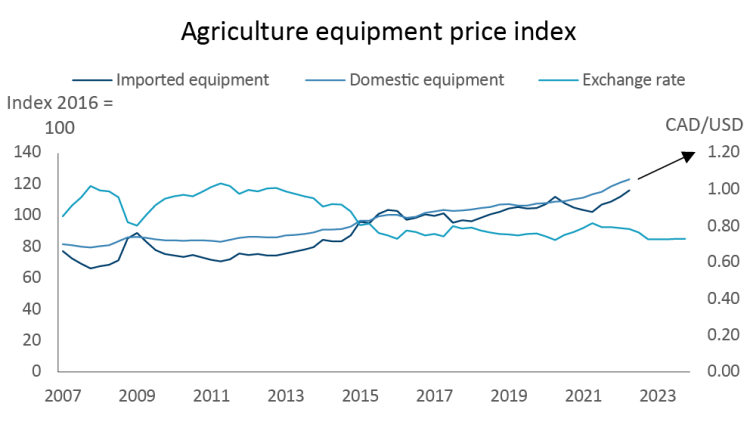2023 Outlook for the farm equipment market

FCC Economics helps you make sense of the top economic trends and issues likely to affect your agri-business in 2023.
Overall demand for farm equipment is projected to remain strong into 2023, despite rising interest rates and a weakening Canadian US exchange rate. Demand is supported by strong farm cash receipts, even with commodity prices softening from peak levels. As supply chains recover, equipment manufacturers are expected to increase the delivery of new equipment orders. However, inventory levels will remain below pre-pandemic levels as we project inventory levels could remain tight beyond 2024.
Sale projections
Sale trends for the remainder of 2022 are expected to be mixed. Higher horsepower tractors, combines, and implement sales are expected to have positive year-over-year growth, while lower horsepower tractor sales are expected to decline in 2022 because of slowing economic growth. Sales of smaller equipment are projected to decline as broad economic conditions worsen in Canada. A slowdown in low-horsepower tractor sales may allow manufacturers to allocate production to higher-horse-powered tractors utilized in agriculture. Further delays in equipment arrival before the end of the year could change these projections.
Farm equipment sales projections for 2023 are projected higher for high horse-powered tractors, combines, and implement sales driven by strong crop receipts:
100+ HP tractor sales to rise 8.7%
4WD tractor sales to rise 13.9%
Combine sales to rise 19.3%
Canadian agricultural implement manufacturing to rise 32.2%
However, small horsepower tractor sales, which are largely driven by the health of the Canadian economy, are expected to slow in 2023:
< 40 HP tractor sales to decline 0.4%
40 – 100 HP tractor sales to rise 0.4%
However, the wild card for 2023 sale projections continues to be the arrival of equipment from manufacturers. Canadian agricultural implement manufacturers are still recovering from supply chain disruptions (Figure 1). Strong demand for farm equipment since 2021 significantly reduced new and used inventories at the dealer level, creating further opportunities for manufacturing sales. Canadian agricultural implement manufacturing sales increased 10% in 2021 and are up 22.3% year-to-date in 2022 through the first 8 months. Canadian agricultural implement manufacturing sales are projected to rise 32.2% in 2023 due to strong demand and price inflation.
Figure 1: Supply chains are improving but are far from pre-pandemic levels

Source: Statistics Canada (NAICS 33311)
Inventory is projected to remain tight
We are anticipating inventory levels will remain tight through 2024 as producer demand remains strong for farm equipment and manufacturers catch up on pre-orders. Inventory levels of new farm equipment have trended below the five-year average (tractors are down 42% and combines down 47%). Strong demand for farm equipment for the remainder of 2022 is expected to reduce inventory levels further and support higher prices. The good news is that equipment manufacturers are expected to adjust their production upward due to the changing economic environment as North American equipment dealers begin to rebuild their inventories. We expect farm equipment dealers to remain 100% sold on new equipment. However, individual dealer revenue remains uncertain and tied to deliveries and allocations from manufacturers. Overall, dealer sale revenue will come down to the number of trades that materialize once new equipment arrives.
Combine inventory projected to remain pressured into 2024
4WD tractor inventory levels are projected to recover slowly
Inventory levels are recovering for smaller horse-powered units
Figure 2: Inventory levels are recovering for smaller horse-powered units

Sources: Association of Equipment Manufacturers, FCC Economic forecast
Figure 3: Combine and 4WD inventory levels projected to remain tight

Sources: Association of Equipment Manufacturers, FCC Economic forecast
Equipment prices
Farm equipment prices are expected to be higher in 2023 due to the depreciation of the Canadian dollar and inflationary pressures in the supply chain that occurred in the last half of 2022. The Canadian dollar has a direct impact on equipment prices. Most new tractors and combines sold in Canada are manufactured south of the border, so an expected depreciation of the loonie through 2023 should lead to price increases on farm machinery (Figure 4). Domestic manufactured equipment, including air drills and seeding equipment, tillage, grain carts, swathers and other “short-line” equipment prices, are less directly connected to the Canadian dollar.
Figure 4: Farm equipment prices are expected to continue trending higher

Sources: Statistics Canada and FCC Calculations
Impact on used equipment and parts market
Supply chain disruptions because of the pandemic-related shutdowns directly impacted the availability of new equipment and parts. Strategic planning on farms meant having additional used equipment available in the event parts and services were unavailable. These farms either kept their older machines or sought used equipment at auctions. Dealers also shifted strategically to servicing or overhauling used equipment to ensure customers could continue using their existing equipment for another year or longer. Inventory in the used equipment market declined as a result. This has had a profound impact on the used equipment market. Throughout 2021-2022 used equipment (e.g., 4-5-years-old) was selling for prices like what they were worth two years earlier.
Two key financial trends to monitor in 2023
1. Interest rates
Interest rates rose throughout 2022 from their historical lows as the Bank of Canada lifted its overnight rate from 0.25% to 3.75%. The Bank of Canada is committed to returning inflation to its 2% target. As a result, borrowing costs are forecasted to rise further in 2022 and possibly early in 2023. In some cases, farm operations have seen their interest expenses more than double. In other instances, prudent financial risk management mitigated the negative influence of higher rates on profit margins. Historically as interest rates rose, farm operators have lengthened their replacement cycle of farm equipment, and farm equipment sales have slowed. Given the backlog in deliveries of new equipment and low inventory levels, we expect that higher borrowing costs will not impact the demand for farm equipment in the short term. Farm income appears strong enough to offset higher short-term input and interest rate costs.
2. Canadian dollar
FCC Economics’ current forecast of the Canadian dollar is to average USD$0.72 through 2023. A declining Canadian dollar will impact both the used and new equipment market. A low Canadian dollar will push prices higher, forcing dealers to re-evaluate their prices on used equipment, given they will have demand from U.S. dealers and farmers, at least adjusting their USD sticker price.
We will continue to monitor these two financial trends. Check back with us in early December when our next Economic and Financial Market Update is released for the latest outlook.
Bottom line
The 2023 farm equipment market will be characterized by a recovery in deliveries of new equipment as supply chains slowly recover. In addition, strong commodity prices will continue to support the demand for farm equipment, so higher interest rates and a lower Canadian dollar may not weaken the demand for farm equipment in the short term. We expect the used equipment market to stay robust for most of 2023 and 2024. Prices in the used equipment market may moderate as delivery of new equipment results in additional trades and inventory of new equipment slowly recovers. Revenue growth for Canadian equipment dealers will continue to come from service and parts as inventories recover for both new and used.
Leigh Anderson
Senior Economist
Leigh Anderson is a Senior Economist at FCC. His focus areas include farm equipment and crop input analysis. Having grown up on a mixed grain and cattle farm in Saskatchewan, he also provides insights and monitoring of Canada’s grain, oilseed and livestock sectors.
Leigh came to FCC in 2015, joining the Economics team. Previously, he worked in the policy branch of the Saskatchewan Ministry of Agriculture. He holds a master’s degree in agricultural economics from the University of Saskatchewan.
